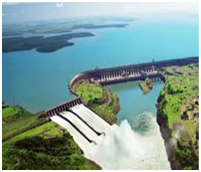
- Paraguay is a bilingual country, unique in the world where a native
language, the Guaraní, is recognized as an official national language
together with Spanish. This cultural blend is seen in Paraguay's forms
of arts, crafts, music, festivals, literature, cinema, fashion and
languages. Paraguayan culture and traditions were highly influenced by
the presence of Jesuit and Franciscan missionaries in the 17th and 18th
centuries, which left magnificent architectural constructions and
sculptures that created the Spanish-Guarani baroque culture. In the
Paraguayan people, indigenous and Spanish influences converge equally,
which makes Paraguay a country of peculiar customs such as the love of
yerba mate and the deep knowledge of natural medicine.
- Handcrafts

- The diversity of cultures in Paraguay is reflected in their crafts.
From the indigenous tradition, beautiful work is carried out in natural
fibers, noble woods, seeds and feathers that become beautiful
tapestries, baskets, necklaces, arrows and other articles of excellent
completion. Paraguayan handicrafts also offer delicate textiles such as
a'o po'í embroidery and ñandutí lace, gold and silver filigree jewelry,
carved horn vessels, hammocks, blankets, wood carved images, ceramic
objects and Infinity of other articles in which the creativity and the
skill of the Paraguayan craftsmen stand out.
- Paraguayan Music and Dance

- The Paraguayan music is very particular, although Paraguay is the
only country in South America where the majority of the inhabitants
speak the language of the native origin; its music is totally of
European origin. The most popular instruments are the harp and the
guitar, the Paraguayan harp is well known throughout the world. Its
genres are Guarania and polka. The first one is characterized by a slow
melody that was created by the Paraguayan Musician, Jose Asunción Flores
in the 1920s and the second one, because of its rapid and lively
melody, is generally used for the traditional dances. The Paraguayan
traditional dance can be danced in pairs or in a group of women called
"galoperas". Another typical dance is the dance of the bottle, where the
main dancer dances with up to 10 bottles in her head one over another.
- Gastronomy

- The typical Paraguayan food is the result of the combination of
Hispanic culinary techniques with the use of native products introduced
by guaraníes such as corn, cassava, and legumes, and others introduced
by the Spanish, such as vegetables, rice and beef. The basic ingredient
of Paraguayan cuisine is corn, which is used for the elaboration of
different typical dishes. The most emblematic dish in Paraguayan cuisine
is the "Sopa Paraguaya", which is a mixture of corn flour with eggs,
fresh cheese, onion and curdled milk. Other traditional maize-based
foods are chipá, mbejú and chipá guasú. Also, beef is present in most
typical Paraguayan dishes such as Chipá So'o, Soyo, Asado, Locro and
others.
- Mate Tea and Tereré

- In Paraguay, the yerba mate is consumed in three different ways, the
first is "mate", which consists in drinking the yerba mate with hot
water and sucking the infusion through a "bombilla" (Paraguayan
traditional straw); the second, "mate cocido", is a tea that is prepared
with hot water and burnt yerba mate. The third is the most popular and
authentically Paraguayan; it is the "tereré", which is a cold or ice
mate. In Paraguay, people usually drink the tereré in groups, among
relatives, friends or with occasional visitors. This drink is common
heritage of all Paraguayans, men, and women, rich, poor, old and young,
all Paraguayans are equally fanatics of this drink.
- Tourism

- Paraguay, a country of roads
- Paraguay maintains the privilege of conserving its great natural
attractions, which are mixed with historical and cultural relics and
great technological works such as the hydroelectric dams of Itaipú and
Yacyreta.
- The Franciscan and Handcraft Way is a path
that follows the footsteps of the Franciscans who founded open villages
in many cities in Paraguay, leaving behind valuable works of art. The
route, which also allows to know the artisans in their own towns, part
from Asunción and leads to Ypané, Altos, Itá, Atyrá, Yaguarón,
Piribebuy, Tobatí, Caacupé, Luque, Valenzuela, Villarrica, Caazapá,
Areguá, Itauguá and San Juan de Nepomuceno.


- The Technological Tourism take you to the most
important sites in which are located the huge hydroelectric dams of
Itaipú in Hernandarias (to the East of the country) and Yacyretá dam in
Ayolas (to the South), as well as the Technological Park of Itaipú.
- The Immense Territory of the Paraguayan Chaco
includes an impressive array of natural landscapes brimming with animal
life. Palmares, estuos, lagoons and dense forests make up these lands,
where a small number of immigrants and fourteen native ethnic groups
contribute to the diversity of cultures in the country.

- Paraguay is a Country of Fishing, Golf and other Sports.
Tourists can enjoy of five internationally recognized and regulated
golf courses, while the mighty Paraguay, Paraná, Tebicuary and others
rivers provide variety and quantity of fish for sport fishermen.
- Eco-adventure is another type of tourism
that can be done in Paraguay. Its mountain ranges, streams and jumps
offer ideal conditions for biking, rappeling, cascading, trekking and
other stimulating disciplines for young people and tourist who love
natural resources and adventures. The Mbaracayú Forest, the Ybytyryzú
Mountain Range and the Vallemí Caverns are some of the favorite
destinations for eco-adventures.

- For more information please visit the website of the National Secretariat of Tourism of Paraguay SENATUR
http://www.senatur.gov.py/










